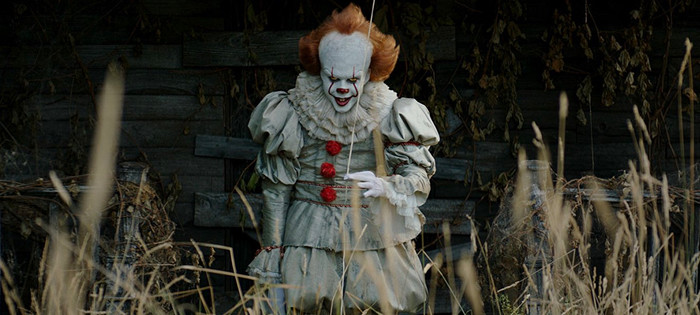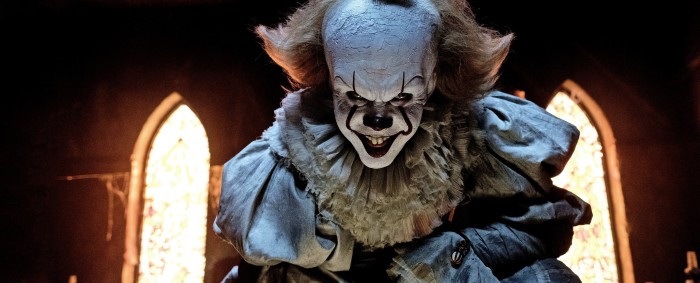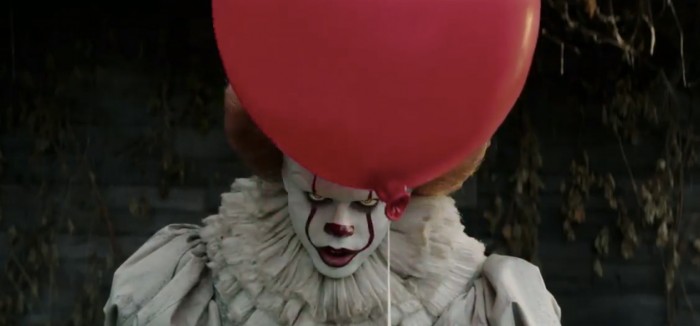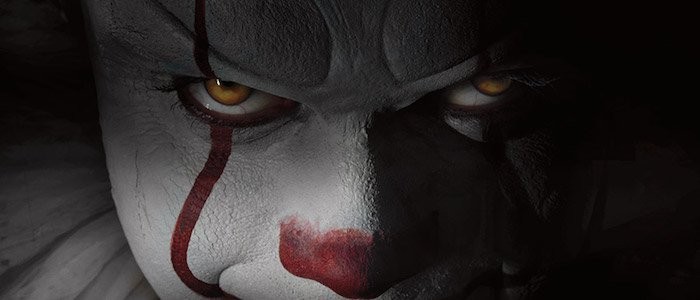How 'It' And The New Pennywise Mirror The Fears Of 2017
The new It has become one of the biggest blockbusters of 2017, and has reinvigorated the box office for the fall. Much of that success comes from the amazing performance of Bill Skarsgård, who transformed himself into the monstrous Pennywise.
Pennywise has been a horror staple for years, thanks both to Stephen King's original novel and Tim Curry's performance as the character in the 1990 TV miniseries. But this Pennywise has definitely been reinvented to match today's times and our struggles, chief of which being our struggle to get over the past. It would seem that for all of our technological advancements, the 21st century is still full of confusion and fear about the future.
On the surface, Pennywise's popularity comes from an almost universal fear of clowns, fears that stem from childhood. But looking deeper, you can see that these fears only still retain their power because of how connected they are to our nostalgia for our childhoods. We closely identify with these fears because they came to us during a time when we felt the most protected and secure. Characters like Pennywise play on this strong connection and exploit it. But when we put Pennywise in today's time, we can see that the character, through his makeup and costume, also says a lot about how our lives currently are being exploited by the strong pull of nostalgia's lies.
Blast From the Past
Pennywise's strength comes from his ability to play on nostalgia, and that's most evident in his costume. Gone are the days of Pennywise's old standard clown costume, which was used more as a way for Pennywise to blend in as a regular clown in the original It. One look at Pennywise's new costume tells the viewer that this isn't Pennywise's first time hunting kids, or even his first time on our earthly plane. That story is told through mixing several different time periods together to present a cohesive, singular look.
"The costume definitely incorporates all these otherworldly past lives, if you will," said costume designer Janie Bryant to Entertainment Weekly. Bryant utilized the styles of several different eras, including the Medieval, Renaissance, Elizabethan, and Victorian styles, to create a timeless, antique creepy doll look for Pennywise.
The fact that Pennywise does look like an old dusty doll makes him even scarier. It's definitely something he uses to his advantage throughout the film, particularly when Pennywise hides among other clown dolls while he's on the hunt for the Losers. The reason his costume alone can incite fear is because it's a definite reminder of the types of porcelain dolls in curio cabinets that we might have seen as kids. These dolls, of course, became extremely scary looking when the lights go out. One of the biggest horror themes is how nostalgia plays a part in what terrorizes us. Namely, what frightened us as children — weird dolls like Annabelle or Chucky, and clowns that look like Pennywise — still have a deep hold on our psyches today.
Pennywise's costume not only plays on the things that used to scare us as kids, but it also plays on It's own focus on nostalgia, particularly how nostalgia charms us, much like Pennywise himself, into believing things that aren't actually true. Similar to how Pennywise's costume is a pastiche of elements from different time periods, the It movies move through nostalgic eras as well. In this reboot, the story takes place in the 1980s, a time period that is especially relevant to moviegoers today because many of the adults in movie theater audiences were kids in the '80s. Despite the scary setting, the '80s are still being used as a "simpler time," when childhood was still magical. The original It also plays off the audience's longing for the past as well; the original TV movie came out in 1990, but it's set in the 1950s, when horror fans who were in their 40s at the time were kids. Were those times actually simpler? No. They were actually quite scary, in their own ways. Pennywise's power comes from the lie of nostalgia, though, a lie that definitely still has resonance today.
Elegance and Youthfulness
If Pennywise's costume is a huge comment on how nostalgia affects us and lies to us, his makeup is a comment on how the more unassuming something looks, the more dangerous it might actually be.
Pennywise's makeup is starkly different from the Curry era of It. There is no classic clown makeup; instead, clown-like motifs are exaggerated into something much more alien. The trick, though, is that the exaggeration isn't overt; it's simplistic and graphic. That graphic quality certainly cements Pennywise into the 21st century; he feels modern, sleek, and futuristic, even while wearing Elizabethan garb.
Entertainment Weekly described the make-up perfectly. "This manifestation of Pennywise from director Andrés Muschietti's film...is elegant, precise—even alluring," wrote EW's Anthony Breznican. "He's in control. It's a stark contrast to the messy, smeared, and dirty scary-clown trend pioneered eight years ago by Heath Ledger's Joker in The Dark Knight." Skarsgård also said to EW that the new look is supposed to be "fresh and original," adding, "It's purposely not going toward that weird greasy look."
The elegance and simplicity of Pennywise's make-up is the only modern element found in this new It. Yes, it has echoes of classic clown makeup, but the way the lines of the mouth crawl up to the eyes in a dark red curve looks more like something out of avant-garde fashion than a horror film. It's this element, coupled with his youthful face, that tickles the mind and makes you wonder just what it is that makes Pennywise tick.
The cleanliness of the make-up also makes it clear that we are now at the demarcation point for grungy horror characters. With grunge comes a relatable, real world aesthetic, and Pennywise is anything but real world.
"There is something inexplicable about Pennywise, and it should be that way," Skarsgård said to the LA Times. "Heath Ledger's Joker is rooted in the real; you can break down the psychology. But Pennywise is not...a real person."
That feeling of something or someone not being real is certainly something we're used to nowadays, what with the advent of a post-truth and "fake news" society. Similarly to how we could still find ways to identify with the Joker, many of us used to feel like we could find ways to identify with anyone, even people we disagreed with. Those days seem sadly behind us. Now, it's hard to know who is real and who is a Pennywise; that is to say, how can we go on in a society that feels like it's not even real anymore?
The makeup, in its weird alien-like quality, hits on the same theme that is present throughout Pennywise's look and in today's world — while time keeps going forward, what keeps us tethered to horror is nostalgia. At this point in time, we are witnessing a volatile mix of both nostalgic and horrifying media, with properties like Stranger Things and Westworld striking a double chord of waxing rhapsodically about the past while showing how grim things can actually be. Combine that with the sense of dread felt due to political upheaval and real world horror happening around the globe, all of which is fueled by a fierce, fanatical clinging to dangerous nostalgia, a longing for a past world. That "simpler" world that never really existed. Once again, it's nostalgia — Pennywise's ultimate weapon — that rules.
With that said, there's no mistake that Pennywise's make-up is the only part of him that looks to be in the present — our present — while the rest of him is swathed in old-timey clothing. Only those of us in the 21st century could see Pennywise's make-up and think of it as familiar to our eyes. His make-up is edgy, boundary-pushing, and, indeed, fashion-forward. And yet, the message the make-up sends is still horror. It's as if Pennywise is saying that while the past might lure you into its frightening submission, the present and the future holds its own terrors as well. No time or place is safe when looking at life through the eyes of fear.
Not even the youth are safe from the tether of nostalgia. In a featurette, Jaeden Lieberher, who plays Bill Denbrough in the film, commented on how scary Pennywise's youth makes him. "It's so scary because he kind of has this young, baby face, but he's so tall and his voice is so squeaky and it's cracking so much," he said.
Sophia Lillis, who plays Beverly Marsh, also commented on Skarsgård's youthful performance. "The first time you see him, he looks like a clown, but he doesn't really act like a clown...Bill Skarsgård kind of gives this certain personality to Pennywise...that you wouldn't really expect. Like a demonic baby animal."
It's often provokes sadness in me when I see young characters as the forces of evil in films. I even feel that way towards Pennywise, since he looks so young (and since Skarsgård himself is young). The reason why is because seeing something so youthful do something so evil is the classic perversion of innocence. We expect people who look young and childlike to still exhibit that untapped innocence, not for them to go on killing sprees.
In the 1990 miniseries, Pennywise didn't play on such a conceit, but this Pennywise definitely does. Pennywise's youthful glow, as it were, is swallowed up in this version of It by the character's tether to nostalgia, which defines the character's porcelain clown doll appearance. Again, Pennywise is saying something about our times; as technologically and culturally savvy as we are, we are still all too willing to be caught up in the tall tales about a time gone by. A real world example — just take a look at the hordes of young people being radicalized by the so-called "alt-right." The present seems like an inescapable doom to many young men who have been lured into the belief of white supremacy. Instead of facing the present and turning it into something worthwhile, these young people are willing to become caught in the alt-right's lies, and they are quickly consumed.
Pennywise’s Message to the 21st Century
Horror, like science fiction, has often had something important to say about current events. This year seems like it'll be defined by the message present in It, and a reinvented Pennywise who is tailor-made for the 21st century. What's ironic is that his message, much like his costuming and make-up, shows how we aren't the forward-looking people we'd like to believe ourselves to be. Instead, Pennywise's message to us is that we look to a facsimile of the past as if it were true, because we as a society are too afraid of what the present and future might hold. Our fears of the present are keeping us in the clutches of a dangerous past, and as a result, we are stuck. In a way, we are floating right along with Georgie. But unlike Georgie, it's almost as if today's society is floating willingly, and that's even scarier than anything Pennywise could cook up.
It's interesting that It has come out at this time in 2017, when we're nearly a year into a presidency that is defined by a return to a white supremacist past and is quickly circling the drain. Environmental catastrophes seem to happen on a nearly-constant basis. Nuclear war seems to be closer with every day. It's funny that a movie that is soaked with nostalgia, led by a horror character defined by nostalgia, has a lot to say about how that powerful emotion can define us for the worst and eat us alive. So how do we escape Pennywise and our own penchant for romanticizing the past? Simple — we can refuse to believe his (and our) lies.
But will we? That question is also at the crux of Pennywise's power over the kids and adults of Derry and the viewing audience. Will we avoid the siren's song of the past and go boldly into the future, or will we be, like Georgie, lured into the depths of evil because we long to be nurtured again, even if that nurturing is all a ruse? Right now, it feels like the longing for nurturing is winning; hopefully, the longing to grow up will prevail in the end.




